Where is Hungary on the art-map of Europe?
Revisiting contemporary art galleries in Budapest prompted this rhetorical question. Could Hungary still retake its place on the art-map of Europe and when will contemporary art from Budapest achieve international recognition? This remains a challenge.
Once there was recognition, fame and glory. There was André Kertész, Martin Munkácsi, Robert Capa, László Moholy-Nagy, Victor Vasarely, Brassaï, Lucien Hervé and Agnes Denes, not to mention George Cukor, Alexander Korda, Vilmos Zsigmond in the film industry. The list is endless.
It is true; these men and women had emigrated and built their careers in the West, not in Hungary; those who stayed home during the Communist era had a much harder life. During the regime, the visual culture was thoroughly erased, and what was left tended to be more about music and literature rather than respecting visual arts as intellectual value.
Yet not much has changed, even under the tyranny of the current Hungarian government art cannot be stopped. The government is desperately holding onto their reins of dictatorial control, destruction, corruption, manipulation, but contradictorily at the same time, a new wave of young galleries and outstanding artists are emerging in contemporary art and photography, especially in the film industry.
It was not long ago, in 2016 that the Oscar went to “Son of Saul” directed by László Nemes. Now, another Hungarian film, “On Body & Soul” by Ildikó Enyedi starring Alexandra Borbély (winner of European Film Awards 2017, Best Actress) will undoubtedly take the Oscars home this year in the Best Foreign Language Film category.
In contemporary art from the older generation, mostly based in Paris, Judit Reigl, Dóra Maurer, Vera Molnár, Simon Hantaï, István Nádler, István Haász have made international galleries bow and collect their art. From the younger generation, mostly based in Budapest, Marcell Esterházy, Alexander Tinei, Péter Hecker, Endre Koronczi, Attila Csörgő have already gained international recognition. In addition to the local art scene, two major art fairs attract visitors: the Budapest Art Week, between 17-22 April 2018, and the Budapest Art Market, between 11-14 October 2018.
For this review, I selected a handful of names from the most prominent young galleries and artists in Budapest.
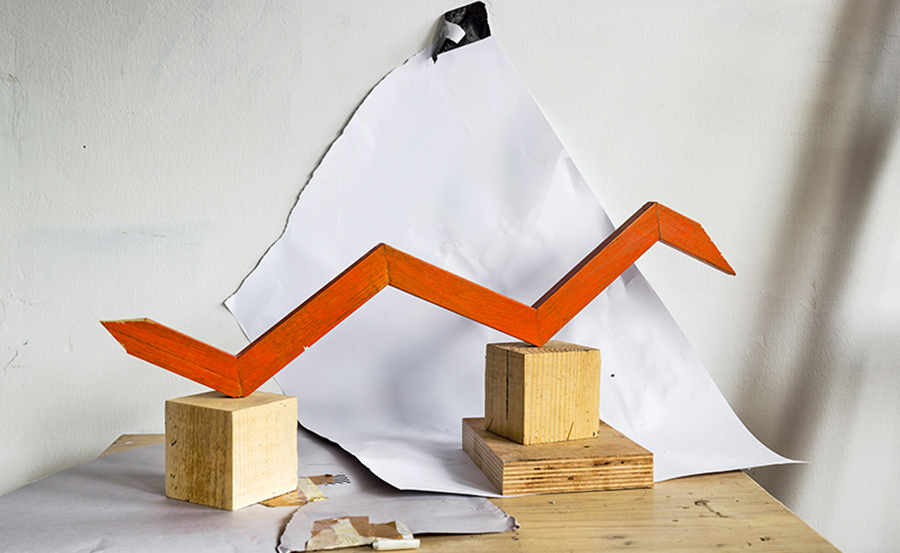
“Thunder” by Peter Puklus / Photo © Courtesy of Peter Puklus
TRAFO GALLERY / PETER PUKLUS
Peter Puklus is not a young emerging photographer although he is young and a photographer. Probably the more appropriate definition for him would be that Peter Puklus is an internationally recognised, celebrated, young photographer-sculptor and multidisciplinary artist, regular at ParisPhoto, Miami UNTITLED, author of many photographic books, father of two children … simply, he is a rare treat.
Although photography is the base of his work, he is unique by using drawings, paintings, sculptures, mixed-media and sound in his photographic installations. He could have been a good friend with Mann Ray or László Moholy-Nagy; however, his inspirations mainly come from nano-details of basic, every day’s life.
Peter Puklus was born in Kolozsvár (Cluj-Napoca) in Transylvania and moved to Budapest in 2000. He is not only a father but a son as well, and that simple fact determined his current exhibition “Life is Techno” at Trafo Gallery. Trafo is a state-run, non-profit, culture hub with an art gallery and a large-scale theatre, mostly know for contemporary dance.
The first impression of “Life is Techno” is, that it is a building site, a house under construction, raw and personal and a bit reminiscent of Kabakov’s latest exhibition at Tate Modern. His storytelling also covers years and generations. The work is epic, just as “Epic Love Story of a Warrior”, his latest 400+ page photographic book.
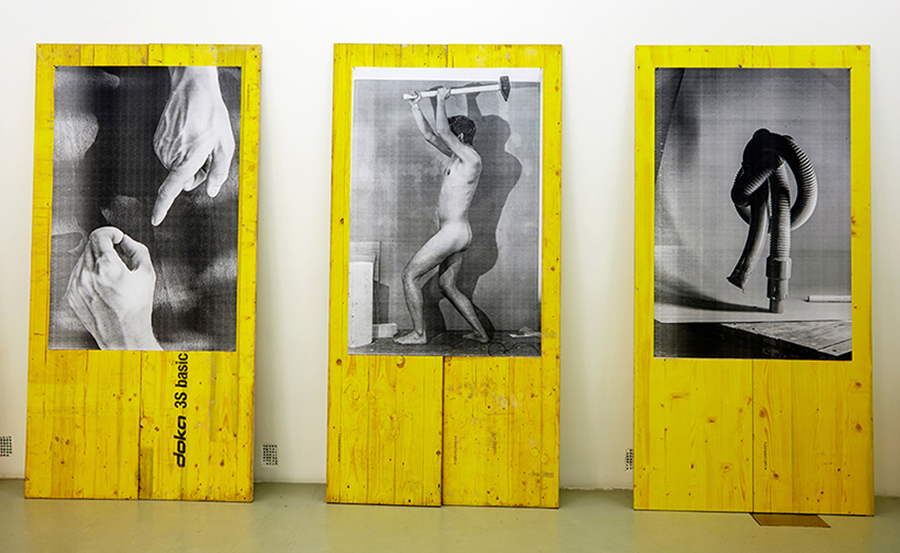
(left) “Fuck Sign”, (middle) “Destroyer”, (right) “The Portrait of the Hero Father” by Peter Puklus / Photo © Courtesy of Peter Puklus
Peter Puklus is conceptually constructive. His blueprint style photographs are mounted on large-scale, wooden boards, 65 ink-drawings are painted on Ikea manuals, an odd, double-sided page from Turgenev’s “Fathers and Sons” book sticks out of the wall, and a giant, black iron grid net with white neon lights divide the gallery into different sections.
The exhibition is filled with metaphors, memories and symbolic images. It is almost as each photograph would have a code, a secret word that after decoding they read together into a sentence, forming the core question of the exhibition: “Could we eventually have a better relationship with our children than we had with our parents?”
Do not wait for the answer, Puklus does not hold the hand of the visitor, everybody is on his own to interpret the work.
The exhibition also includes a large photographic print of Ceausescu, the executed ex-Romanian dictator. Puklus was only nine years old when he watched the shooting and the revolution live on television. It had a significant impact on him. When a few days later he returned to school, the portraits of Ceausescu from each classroom was removed, and students were asked to tear out the first page of their schoolbooks with the picture of the ex-leader. Puklus could not violate his books; books were always sacred to him; however, he came up with a creative solution to put wholes through Ceausescu’s eyes and make him symbolically blind. The image is now enlarged into a print and exhibited as part of his childhood memories.

(left) “Dirty T-shirt, (right) “Breastfeeding Hammer” by Peter Puklus / Photo © Courtesy of Peter Puklus
Throughout the exhibition, the father/son/father relationship is beautifully developed, from love, care to conflicts and generation-related problems. His relationship with his son and with his father (him being in the middle) creates a strong bond between them.
The sound installation “444 Hang-Over” comes through a headphone, a compilation of techno music put together by the artist since his son was born. For him, techno is a mono-rhythm sound that does not make much sense for the first time, but when it is re-listened, details develop and the rhythm does not sound the same. It is a bit like life; each time when we look back at the same situation, we look at it differently.
In September “A Hős Anya” (The Hero Mother) will follow his current concept Father/Son to Mother/Son. The exhibition is scheduled for a solo show in Switzerland during the Festival Vevey, then later in Budapest at Glassyard.
His plans include filmmaking, not only as a simple reconstruction of his art installations but involve other fellow artists from different backgrounds to collaborate.
His upcoming exhibitions will be at Robert Morat Gallery (Berlin), C/O Gallery (Berlin), Galerie Conrads (Düsseldorf) and Glassyard (Budapest).
TRAFO Gallery, Liliom utca 41, Budapest 1088, Hungary / “Life is techno” by Peter Puklus / until 11 March 2018

(left) “Balaton”, (right) “Dunaföldvár” and “Abu Dhabi” by Akos Major / Photo © Courtesy of TOBE Gallery
TOBE GALLERY / AKOS MAJOR
After having probably the smallest gallery in the city, TOBE Gallery moved to a stripped out empty store space in the fashionable Palace district of Budapest in 2017, which has the most elaborate and distinguished palaces, once housing the National Assembly of the Parliament (today, the Italian Cultural Institute).
TOBE is a Fine Art gallery, a beautiful child of a Hungarian-Venezuelan Tomas Opitz (TO) and Bea Puskás (BE), focusing on Ibero-American and Hungarian contemporary photography.
With architecture degree from Caracas, Tomas moved to Hungary in 2003; meanwhile, Bea got her degree in geology and developed a keen interest in contemporary art. Combining her knowledge in cultural management and his passion for photography, TOBE Gallery, a pied-a-terre art-space was born in 2013. Their unique, multi-cultural programme brought already many Ibero-American and Hungarian artists together.
In November 2017, TOBE reopened in their new gallery space with a group show “Güelcome” presenting 14 contemporary artists. The gallery is currently presenting a solo-show of photographer Akos Major for the first time and later this year planning an exceptional show of Mathieu Asselin, well-known for his latest “Monsanto” photographic investigation project.
“Our ambition is to exhibit young, emerging photographers, to bring them together and send the message out to our local Hungarian citizens to give photography a better value. Bring it to the level of art, make it accessible, collectable and to express and communicate photography in the art as many different ways and forms as possible”.
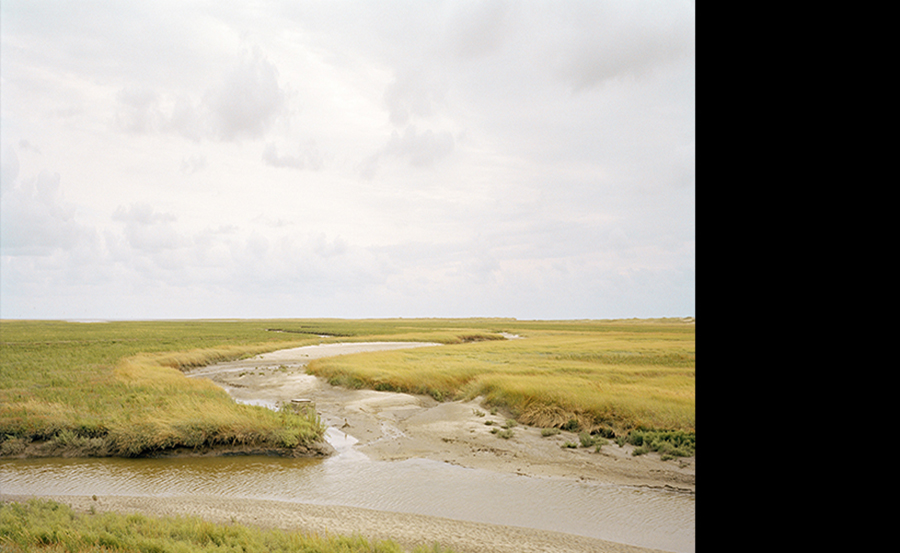
“St Peter Ording” by Akos Major / Photo © Courtesy of TOBE Gallery
The exhibition “Rend” (Order) is a selection of Akos Major’s work from the past five years, an on-going series of images of Hungary and from his trips to Italy, Germany, Thailand, also to Dubai, New York and Istanbul. His pictures follow a strict theme between nature and urban still-lives. The pale greys and blues in this radiant series are just simply stunning. The people echo the same level of placidity as their environment, in another series as water. His diptychs are deliberately pairing different cities together, Dubai/ New York, New York/Istanbul, Caorle/Nagydörög and go well beyond the surface of just being an aesthetic picture.
Although his photographic work is extremely calm and projects a very relaxed atmosphere combined with painstakingly worked-out composition, geometry and colour scheme, there is an unspoken level to the series. Hidden tension, oppression, even frustration echo his work as a reflection of today’s life in Hungary and the burden history that the country still carries.
TOBE Gallery, Bródy Sándor utca 36, Budapest 1088, Hungary / “Order” by Akos Major / until 10 February 2018
TOBE Gallery’s future exhibition with Dafna Talmor, a UK based photographer, during Budapest Art Week / 17 – 22 April 2018
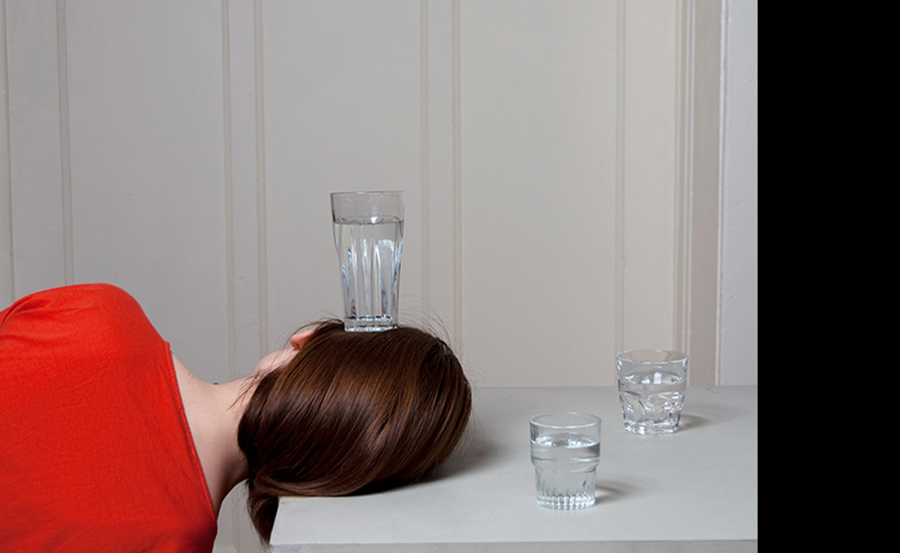
“The Glass’ from the Good Luck series by Csilla Klenyánszki / Photo © Courtesy of Csilla Klenyánszki
TRAPEZ GALLERY / CSILLA KLENYANSZKI
Facing the gorgeous Károlyi Garden in the heart of Budapest, Trapéz Gallery is still considered as a young, contemporary gallery, although it has been actively working since 2012 representing emerging Hungarian and international artists. Their youth is probably due to their fresh approach, pioneer work and brave decision-making. The gallery functions more like a laboratory focusing on research, dynamic experimentations, events and panel talks. It also functions as a project incubator and production space fostering collaborations with artists and curators.
In 2017, the gallery debuted at ParisPhoto with a fine selection of photographers, including László Lakner, John Major, Andi Schmied, Csilla Klenyánszki.
Csilla Klenyánszki currently lives and works in Amsterdam. Her photographic work has been exhibited in numerous international galleries and art fairs, including ParisPhoto in 2017.
2018 is going to be an equally exciting year for her. A few days ago she was selected for the 33rd Festival d’Hyères, which is one of the most prominent photographic and fashion festivals in France. Only one other Hungarian photographer in the past, Peter Puklus, could make it. Now during one week, the South of France and the Villa Noailles will be embracing her new photographic series “Pillars of home”.
Before the Festival d’Hyères the Mondrian Found’s “Prospects & Concepts” will show her latest photographic series during Art Rotterdam in the Netherlands, followed by an exhibition in Utrecht then “Solo Duo” with another Hungarian photographer David Biró in Trapéz Gallery in Budapest.
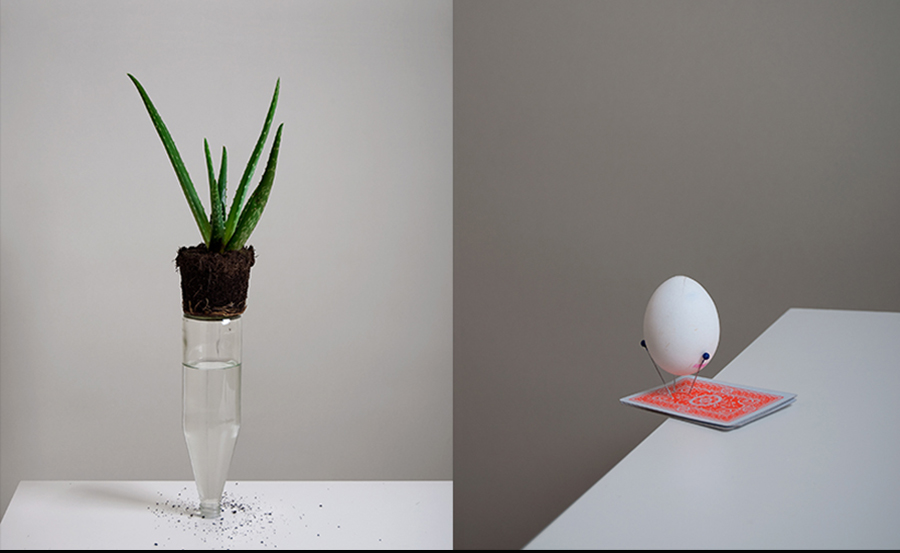
(left) “Plant on Bottle”, (right) “Egg on Pins” from the Good Luck series by Csilla Klenyánszki / Photo © Courtesy of Csilla Klenyánszki
For her latest series “Good Luck” the only thing Csilla Klenyánszki does not need is luck. Her work is already well-founded and stable. Her research work is based on “balance” and its interpretation, on her life-circumstances and personal environment. Balance is a fascinating subject as it is not just an object but has substantial physical and mental implications as well.
The series “Good Luck” reveals moments of balancing, where almost everything is perfectly still. As these ephemeral moments are fragile, intense concentration is required to achieve the images. Klenyánszki creates her installations where different elements, mostly domestic and even banal objects have to interact, as they are physically holding each other, keeping the objects and the picture together from falling apart.
Before her photo sessions, she makes sketches and works painstakingly on pre-meditated staged photography; other times her approach might seem random, but looking closer the details reveal. It is a play on balance and stability, an interaction between the female body and common domestic objects.
The images often include a body, a female body, herself, but faceless as her identity is irrelevant to the result. It is constant research of the body that is the core element of her installations; a borderline between body and object where she is deliberately dehumanising the body and humanising the object. Her photographic work reminds us of a frozen moment of Pina Bausch dance performances.
The nature of her work is playful and experimental; the approach is professional and analytic. Her artistic methods balance between installations and performance art and these precise moments can be interpreted as pure meditation.
TRAPÉZ Gallery, Henszlmann Imre utca 3, Budapest 1053, Hungary / “Solo Duo” by Csilla Klenyánszki / 22 March – 4 May 2018
VILLA NOAILLES, during the 33rd Festival d’Hyères, Hyères, France / “Pillars of home” by Csilla Klenyánszki / 26 – 30 April 2018

“Private Trap 3.0 Skull “ by Csongor G Szigeti / Photo © Courtesy of Csongor G Szigeti
ESERNYOS GALLERY / CSONGOR G SZIGETI
There is public art, street artists and there is Csongor G Szigeti who is not just a multidisciplinary, public-art and intermedia artist but also a workshop-surfer and a university teacher. Born in Csikszereda (Miercurea Ciuc) in Transylvania, Csongor G Szigeti subsequently moved to Budapest in 1980.
He is not attached to any particular gallery, which is not unusual in Hungary, as most artists have to deal with self-management besides their artistic work. Szigeti is also a very spontaneous man, who values his artistic freedom and displays his work with no compromise often in urban settings or on a vast field in the countryside. By following this path, he can act and react much quicker as an individual artist rather than wait to be exhibited in a gallery.
His earlier installations “Spacesheeps”, “Fractal Wind”, “Refugees in the East Carpathians” and “Scope Steel”, the latter shown in a church in Eger, gained him national recognition. In 2017, he collaborated with Horizon Gallery with a solo-show “Aetheral” that started off with a strong message: machines are friends, people are enemies.
“Aetheral” was a provocative exhibition, inspired by the Japanese Hikikomori effect, displaying a dozen of pink, plastic, robotic, sex-dolls that randomly moved around the gallery like Dyson robot-cleaners. The dolls were dressed as nurses and were equipped with a sensor to avoid obstacles, although very often they bumped into each other causing random, creative chaos. The clinical setting perfectly reflected Szigeti’s artistic sincerity, sarcastic humour and playfulness.
Plastic pleasures, robotic desires, it was a journey into social utopia. A frightening thought was hovering above his head that pre-programmed, robotic love will eventually take over feelings, romantic ideologies and distortion will become the norm and reality. He was impressed but concerned and anxious about the potential of the inventions of the human mind which rightfully raised the question … “Will rigid, sex-consummation be able to knock out sensuality?”
Strangely, Szigeti’s utopia in many ways is already our reality. We are constantly and desperately depended on mobile phones, apps, and most gadgets; home appliances could only operate by Siri or Alexa, controlling practically every breath we take.

“Private Trap 1.0 Heart” by Csongor G Szigeti / Photo © Courtesy of Csongor G Szigeti
Currently, Esernyős Gallery houses “Keep Your Trap Shut” his large-scale installation, shown for the first time. The gallery was an empty library building until the property finally gained its present form in autumn 2015. Restored and state-run by the municipality of Óbuda district, the art complex showcases contemporary art shows, emerging artists and creates a communal meeting place and workshops.
Szigeti’s inspiration came years ago when just outside his art studio at Art Quarter Budapest he found a large, odd shape cage, a mousetrap. That summer he went to Montenegro and was surprised to find similar shape fishing-pots in metal left on the beach. They reminded him of traps, and when he returned to Budapest, he started working on the Human Trap/Private Trap series.
“Private Trap 1.0 Heart” was the first one and installed on the fields of Noszvaj. The large red heart was a humoristic-ironic response to a broken love affair. Soon after “Private Trap 2.0 Dome” was launched on Lake Velence, then “Private Trap 3.0 Skull”, “Private Trap 4.0 Tetra” and “Private Trap 5.0 Self” were created, the latter as the artist own trap.

Installation “Keep Your Trap Shut” by Csongor G Szigeti / Photo © Courtesy of Csongor G Szigeti
His current exhibition “Keep Your Trap Shut” gathers all his large-scale traps under one roof. It is a fine selection of metal cages working on the principle of mousetraps and Fyke fishing nets, appearing as geometric shapes, 3D low-polygons, other times as anthropomorphic forms and giant skulls.
The art pieces, made out of concrete reinforcing bars used in construction work, are painted and welded into large-scales. Lights and shadows play a significant part of the installation specifically designed for the gallery, displaying the nature of the real and fictive human traps. The giant skull projects a giant shadow-monster on the wall. It is also a trap. Men trap animals, animals trap men, men trap men, and they trap themselves. Even the gallery functions as a trap.
In the courtyard “Private Trap 2.0 Dome” is installed as part of public art. The sound installation is created by media-artist DJ Tatlin, a mix of electronic soundscapes and metallic noises of welding. The traps were constructed in a way that anyone can enter them but at one’s own risk; as inside the long metal nails make it difficult to exit. Escaping requires a bit of challenge and willpower, as much as the artist would like us to be challenged.
ESERNYOS Gallery, Fő tér 2, Budapest 1033, Hungary / “Keep Your Trap Shut” by Csongor G Szigeti / until 25 February 2018
Top Photo: “The Glass” by Csilla Klenyánszki, “St Peter-Ording” by Akos Major, “Private Trap 3.0 Skull “ by Csongor G Szigeti / Photo-montage © Courtesy of ZOLTAN+
Text and photos by courtesy of Zoltan Alexander © ZOLTAN+ London
www.zoltanplus.com

